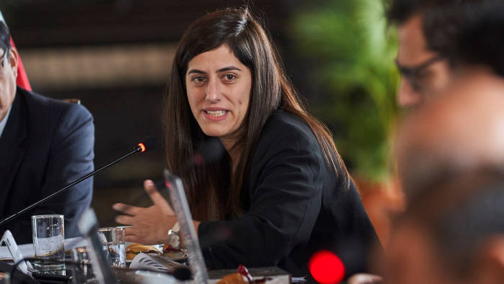
(above) María Antonieta Alva is one of the few women to hold the job of economy minister in Latin America © Christian Ugarte/EPA-EFE
Peru tries to emerge from shadow of corruption scandal
March 12, 2020 - Original article: Financial Times
Task of restoring once-stellar growth falls to country's youngest-ever finance minister
Gideon Long in Lima
María Antonieta Alva is taking over as Peru's economy minister at a challenging time.
She was just 34 years old when she was sworn in last October, four days after President Martín Vizcarra dissolved Congress -- a move one local analyst described as "the most momentous political event in Peru since 1992", when then-president Alberto Fujimori ordered tanks on to the streets to shut down parliament.
Peru's youngest ever economy minister -- and a rare female finance minister in Latin America -- Ms Alva has inherited an economy at its lowest ebb for a decade. Growth has been hit by a subdued mining sector, the impact of climate change and the lingering impact of the Lava Jato or "Car Wash" corruption scandal, which has taken a bigger toll on Peru than on any country outside its nation of origin, Brazil.
The IMF said "the findings of the Lava Jato investigation hampered large investment projects" in Peru last year and "raised concerns about long-term growth prospects". That worries Ms Alva. "In the longer term, we know that Peru needs a potential growth rate of around 5 per cent to make the jump to being a developed country and to avoid falling into the middle-income trap," she told the Financial Times in her offices in Lima. In 2019, the Peruvian economy expanded 2.2 per cent, down from 4 per cent a year earlier.
Ms Alva blames "supply shocks", including a 26 per cent drop in fishing production due in part to climate change, for the low growth. Peru is the world's largest producer of fishmeal and fishing is vital to its economy.
She said external shocks -- principally the US-Chinese trade war -- knocked a further 0.4 per cent off growth but insisted the economy would expand 4 per cent this year. The IMF forecasts growth of 3.2 per cent, while many economists expect a rate close to 3 per cent or less, particularly if the coronavirus outbreak worsens.
With its open, commodity-exporting economy, Peru is exposed to any slowdown in China, which accounts for 28 per cent of Peruvian exports and 70 per cent of its copper sales.
Then there is Lava Jato -- a Brazilian money-laundering probe that expanded into Latin America's largest anti-graft investigation. Three past Peruvian presidents are under investigation for links to the scandal. A fourth, Alan García, committed suicide last year when prosecutors tried to arrest him. Keiko Fujimori, an opposition leader and former presidential candidate, is in jail awaiting trial for alleged corruption.
The scandal has dented business confidence in Peru, taking the shine off one of the standout Latin American economies of the 21st century. "
It's changed the behaviour of public officials," said Alonso Segura, a former economy minister and professor at Lima's Pontifical Catholic University. "They've become much more wary of signing contracts even with companies that have nothing to do with Lava Jato. That's had a knock-on effect on the economy, dampening public and private investment".
In a bid to move on from Lava Jato, the Vizcarra government has unveiled a portfolio of 52 infrastructure projects, worth 13 per cent of annual gross domestic product, to be executed over the next decade. They include a new ring road for Lima and a train between the cities of Huancayo and Huancavelica, high in the Andes.
The portfolio also includes much-needed mining projects, after virtually no production growth in Peru's mining and oil sectors last year. While Anglo American is still investing heavily in its huge Quellaveco copper project in the south of the country, elsewhere -- at Chinese state-owned mine Toromocho and Peruvian-owned Mina Justa, for example -- investment is due to end this year.
Thorne & Associates, a financial advisory, expects mining investment to grow just 2.5 per cent in 2020 after jumping 22 per cent last year.
In December, Mr Vizcarra's government bowed to the inevitable and acknowledged it would miss its target of closing the fiscal deficit to 1 per cent of GDP by 2021. It has pushed that back to 2024. Recommended Peru Peru's anti-graft push boosted by opposition defeat "
We haven't changed the fiscal rule, we've changed the calendar," said Ms Alva. "This will help smooth the path for fiscal consolidation. We spoke to the risk agencies and the IMF before taking the decision. It's basically about freeing up money for infrastructure investment."
The IMF -- not known for applauding fiscal laxity -- welcomed the move, noting the government's "intent to use the extra room for public investment". That is a testament to Peru's sound economic fundamentals. At 27 per cent of GDP, public debt is the lowest among the major Latin American economies, and the fiscal deficit narrowed to 1.6 per cent of GDP last year, its lowest level since 2014.
But the country has a large black market -- 70 per cent of the Peruvian labour force work informally, compared with an average of 54 per cent across Latin America, according to the IMF -- meaning it does not collect enough tax. "We have a real challenge in terms of collecting taxes," said Ms Alva. "The tax take as a percentage of GDP has been stagnant for the past 10 years and we're lagging behind on this issue."
But for Ms Alva, a more immediate concern is getting the 2020 budget through Congress. Mr Vizcarra approved it by executive order in November but once parliament is back, lawmakers will review it, along with other measures put forward by Ms Alva's ministry.
After that, Ms Alva said, "we plan to push ahead with a new legislative agenda".